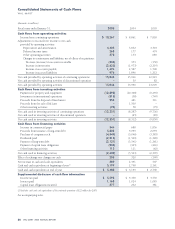Walmart 2005 Annual Report Download - page 28
Download and view the complete annual report
Please find page 28 of the 2005 Walmart annual report below. You can navigate through the pages in the report by either clicking on the pages listed below, or by using the keyword search tool below to find specific information within the annual report.
Management’s Discussion and Analysis of
Results of Operations and Financial Condition
W A L -M A R T
26 WAL-MART 2005 ANNUAL REPORT
Our total gross profit as a percentage of net sales (our “gross mar-
gin”) was 22.9%, 22.5% and 22.3% in fiscal 2005, 2004 and
2003, respectively. Our Wal-Mart Stores and International segment
sales yield higher gross margins than our SAM’S CLUB segment.
Accordingly, the greater increases in net sales for the Wal-Mart
Stores and International segments in fiscal 2005 and 2004 had
a favorable impact on the company’s total gross margin.
Operating, selling, general and administrative expenses (“operat-
ing expenses”) as a percentage of net sales were 17.9%, 17.5% and
17.4% for fiscal 2005, 2004 and 2003, respectively. The increase
in operating expenses as a percentage of total net sales was pri-
marily due to a faster rate of growth in operating expenses in our
Wal-Mart Stores and International segments, which have higher
operating expenses as a percentage of segment net sales than our
SAM’S CLUB segment. Operating expenses in fiscal 2005 were
impacted by the Wal-Mart Stores and SAM’S CLUB segments’
implementation of a new job classification and pay structure for
hourly field associates in the United States. The job classification
and pay structure, which was implemented in the second quarter
of fiscal 2005, was designed to help maintain internal equity and
external competitiveness.
Operating expenses in fiscal 2004 were impacted by the adoption
of Emerging Issues Task Force Issue No. 02-16, “Accounting by a
Reseller for Cash Consideration Received from a Vendor” (“EITF
02-16”). The adoption of EITF 02-16 resulted in an after-tax
reduction in fiscal 2004 net income of approximately $140 million.
Interest, net, as a percentage of net sales increased slightly in fis-
cal 2005 when compared with fiscal 2004 due to higher borrow-
ing levels and higher interest rates during fiscal 2005. For fiscal
2004, interest, net, as a percentage of net sales decreased 0.1%
when compared to fiscal 2003, primarily from lower average inter-
est rates on our outstanding debt and the positive impact of our
fixed-to-variable interest rate-swap program.
Our effective income tax rates for fiscal 2005, 2004 and 2003
were 34.7%, 36.1% and 35.2%, respectively. The reduction in
our effective tax rate from fiscal 2004 to fiscal 2005 is due to
the passage of the Working Families Tax-Relief Act of 2004 in
October 2004, which retroactively extended the work oppor-
tunity tax credit for fiscal 2005. Additionally, our fiscal 2004
effective tax rate was impacted by an increase to our valuation
allowance. As a result of tax legislation in Germany in January
2004, we re-evaluated the recoverability of our deferred tax asset
in Germany. This re-evaluation resulted in a $150 million charge
to increase our valuation allowance in fiscal 2004. This increase
in our valuation allowance caused our effective tax rate to rise to
36.1% in fiscal 2004.
In fiscal 2005, we earned income from continuing operations of
$10.3 billion, a 15.9% increase over fiscal 2004. Net income in
fiscal 2005 increased 13.4% from fiscal 2004 largely as a result
of the increase in income from continuing operations described
above, net of the $193 million previously provided in fiscal 2004
by McLane, which was disposed in the first half of fiscal 2004 and
accounted for as a discontinued operation in that period. During
fiscal 2004, we earned income from continuing operations of
$8.9 billion, a 13.3% increase over fiscal 2003. Our net income
increased 13.8% over the same period largely as a result of the
increase in income from continuing operations described above
and the $151 million after-tax gain on the sale of McLane recog-
nized in fiscal 2004.
The segment net sales increases in fiscal 2005 and fiscal 2004
from the prior fiscal years resulted from comparative store sales
increases of 2.9% in fiscal 2005 and 3.9% in fiscal 2004, in addi-
tion to our expansion program in the Wal-Mart Stores segment.
We believe that comparative store sales in 2005 increased at a
slower rate than 2004 due to a softer economy and because our
customers have been impacted by higher fuel and utility costs.
Our expansion programs consist of opening new units, convert-
ing Discount Stores to Supercenters, relocations that result in
more square footage, as well as expansions of existing stores.
Segment expansion during fiscal 2005 included the opening of 36
Discount Stores, 21 Neighborhood Markets and 242 Supercenters
(including the conversion and/or relocation of 159 existing
Discount Stores into Supercenters). Two Discount Stores closed
in fiscal 2005. During fiscal 2005, our total expansion program
added approximately 36 million of store square footage, an 8.6%
increase. Segment expansion during fiscal 2004 included the
opening of 41 Discount Stores, 15 Neighborhood Markets and
213 Supercenters (including the conversion and/or relocation of
130 existing Discount Stores into Supercenters). One Discount
Store closed in fiscal 2004. During fiscal 2004, our total expan-
sion program added approximately 34 million, or 8.8%, of store
square footage.
While our fiscal 2005 segment operating income as a percentage
of segment net sales was unchanged from fiscal 2004, segment
gross margin and operating expenses as a percent of sales were
each up 0.4% for the year. Our gross margin improvement can be
primarily attributed to our global sourcing effort and reductions in
markdowns and shrinkage as a percentage of segment net sales for
Wal-Mart Stores Segment
Segment Net Sales Increase Segment Operating Segment Operating Income Operating Income as a
Fiscal Year from Prior Fiscal Year Income (in millions) Increase from Prior Fiscal Year Percentage of Segment Sales
2005 10.1% $14,163 9.7% 7.4%
2004 10.9% 12,916 9.1% 7.4%
2003 12.9% 11,840 16.2% 7.5%
























